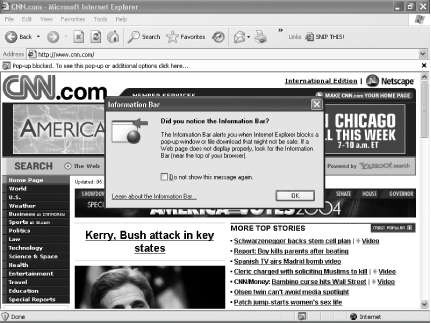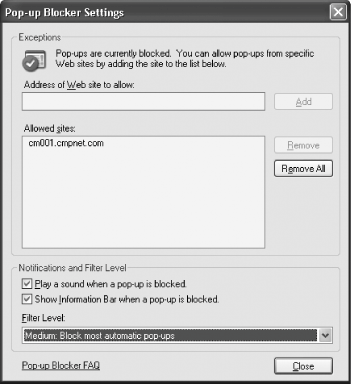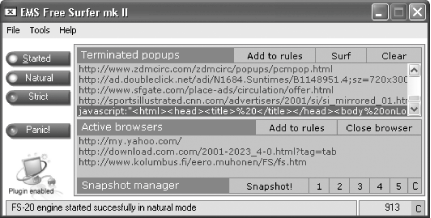Hack33.Stop Pop Ups with SP2and Without It
|
Hack 33. Stop Pop Ups with SP2and Without It
You don't have to be victimized by obnoxious pop-up ads and web sites on the Internet. Fight back with these tips and tools. Surfing the Web used to be such a simple, enjoyable experience. Go to the web site of your choice, enjoy the page, and head somewhere else. No longer. At times, it now seems like a sleazy carnival midway, complete with flashing lights and loud music, barkers pleading at you to venture into the sideshows, scamsters promising you big payoffs if you try three-card Monte, and no-goodniks lurking in the shadows. For that, we have pop ups to thank. Pop ups are ads that, as the name implies, pop up over your browser, usually in a smaller window, and frequently contain flashing messages and other kinds of obnoxious come-ons. The infamous X10 surveillance camera pioneered this insufferable form of advertising, and now it's everywhere. Pop ups are more than just insufferable annoyances, however. They can be dangerous as well. Click one of their come-ons, and you might unwittingly download spyware or a Trojan horse onto your PC.
You don't have to be victimized by them, though. As you'll see in the rest of this hack, there are things you can do to keep your PC from resembling a virtual midway. 4.3.1. Use SP2's Built-In Pop-Up BlockerIf you haven't upgraded to Windows XP Service Pack 2 (SP2), there's at least one good reason why you should: Internet Explorer's built-in pop-up blocker. It does an exceptional job of blocking pop ups, and it lets you allow pop ups from some sites while banning them from all others.
By default, the pop-up blocker is turned on. Visit a site with a pop up, and you'll see a screen like the one shown in Figure 4-2. Figure 4-2. Internet Explorer's notification of a blocked pop up There are two things of note here. First, at the top of the screen, you'll see what's called the Information Bar, which tells you a pop up was blocked. Then, right in the middle of the screen, you'll see a screen telling you to look at the Information Bar. Clearly, that notification is unnecessary, so select "Do not show this message again" and click OK. Normally, you don't want to see a pop up, so you wouldn't need to do anything else at this point, beyond breathing a sigh of relief that a pop up was blocked. But in some instances, you want to let a pop up through. On occasion, a site will use pop ups for some good purposefor example, to deliver more information in a small window. If you want to allow pop ups through from the site, click the Information Bar, and you'll see the screen shown in Figure 4-3. Choose Temporarily Allow Pop-ups to allow pop ups from the site on just this visit, and choose Always Allow Pop-ups from This Site if you want to always let pop ups from the site through. Whichever you choose, the pop up will be let through immediately. Figure 4-3. Allowing pop ups just for this visit If you want to turn off the pop-up blocker altogether, choose Settings But what happens if you've chosen to permanently allow pop ups from a site and later decide you no longer want to let them through? It's easy to tell the pop-up blocker to no longer let those pop ups through.
Choose Tools Figure 4-4. Customizing your pop-up settings All the sites you've decided to allow pop ups from are in the "Allowed sites" box. To no longer allow pop ups from any of those sites, highlight the sites and click Remove. If you want to allow more sites than those shown here, type each site into the "Address of Web site to allow" box and click Add. You can also tell Internet Explorer how aggressively to block pop ups, by choosing a different filter level from the Filter Level drop-down box. There are three levels you can choose:
Finally, the screen lets you choose to play a sound when a pop up is blocked. It also gives you the option of having the Information Bar be displayed when a pop up is blocked. 4.3.2. Download Software to Stop Pop Ups in IEIf you don't have SP2, you'll still want to block pop ups, of course. There are many for-pay pop-up killers, but if you don't want to spend the cash, you can get an excellent one for free: EMS Free Surfer mk II, shown in Figure 4-5. It lets you set several levels of pop-up protectionyou can block all pop ups or only those that appear to be unwantedand you can turn it on and off with a click. Figure 4-5. EMS Free Surfer mk II It has other helpful tools as well, such as letting you shut every open instance of Internet Explorer with a single click, and it includes an add-in that will clean out your system cache and list of recently visited sites. Get it at http://www.kolumbus.fi/eero.muhonen/FS/fs.htm. (Don't confuse it with a related product, EMS Free Surfer Companion, which offers more features than the free version and costs $20.) Another good pop-up blocker is Pop-Up No-No!, available from http://www.popupnono.com. It blocks Flash animation ads, as well as pop ups. (For more details, see [Hack #42] .) 4.3.3. Ditch IE: Use a Different Browser to Stop Pop UpsHere's one way to get rid of pop-up annoyances: skip Internet Explorer altogether! Opera, Mozilla, and Firefox all include built-in pop-up killers as a menu option. 4.3.3.1 OperaDownload Opera from http://www.opera.com. To enable its pop-up killer, choose File 4.3.3.2 MozillaDownload Mozilla from http://www.mozilla.org. To enable its pop-up killer, choose Edit 4.3.3.3 FirefoxDownload Firefox from http://www.mozilla.org/products/firefox. To enable its pop-up killer, choose Tools 4.3.4. Stop Messenger Service Pop UpsA year or more ago, the most obnoxious pop ups of all started to appear on computer users' screens: pop ups that aren't connected to a browser, that appear even when you're not surfing the Web, and that show up in a text-message window for no apparent reason. You've taken no conceivable action that could have caused them to appear, such as visiting a web site. And yet there they are. These text pop ups use XP's Messenger service, which was designed for sending notifications over internal local area networksfor example, when a network administrator wants to notify network users that a server is about to go down, or when you're notified that a printer has completed a job of yours.
But spammers took hold of the technology and now blast out text pop ups to IP addresses across the Internet. How ubiquitous are these pop ups becoming? When I bought a new laptop, within 10 minutes of turning it on for the first time I had received my first Messenger service pop up. To kill these pop ups, disable the Messenger service. Run the Services Microsoft Management Console by typing services.msc at a command prompt or the Run box and pressing Enter. Double-click the entry for Messenger, choose Disabled as the Startup type from the screen that appears, and click OK. Pop ups will no longer get through. Unfortunately, neither will any network messages from administrators if you're on a LAN. If you're running a router at home that allows you to block ports, you can kill these messages by disabling port 135. How you do this varies according to your router. To do it on some models of Linksys routers, go to the router administrator screen and choose Advanced By the way, another good reason to download and install SP2 is that it automatically turns off Messenger Service pop ups. 4.3.5. See Also
|
|
EAN: 2147483647
Pages: 191

 Pop-up Blocker
Pop-up Blocker 